
Uganda's prime minister said Nov. 1 that his country has decided to pull out of the African Union's peacekeeping missions in Somalia and elsewhere in response to a leaked U.N. report accusing Uganda and Rwanda of arming a rebel group in the Democratic Republic of the Congo. The African Union Mission in Somalia peacekeeping force, more commonly known as AMISOM, is composed of more than 17,000 troops from Kenya, Uganda, Djibouti, Sierra Leone and Burundi. More than a third of the troops come from Uganda and a quarter come from Kenya. Ethiopia has a few thousand troops also operating in Somalia, but they are mainly focused on enforcing border security and are not under AMISOM's control. While AMISOM units from different countries may work together toward a common goal, the units themselves are not mixed by nationality and each country's forces have generally focused on their own geographic areas of concern. The Ugandan contingent's chief goal has been securing Mogadishu, while the Kenyans have focused on the south near Kismayo. Djiboutian and Burundian troops have been primarily concentrated in and around Mogadishu in central Somalia. Uganda's threat to abandon the peacekeeping mission comes shortly after one of AMISOM's biggest successes. In late September, Kenyan forces took control of Kismayo, al Shabaab's prized base in the south. Still, the jihadist militant group has continued to conduct strikes in Mogadishu against journalists, politicians, clan elders and military forces. If the Ugandans were to withdraw, which remains unlikely despite the prime minister's assertions, Burundian and Djiboutian forces stationed in Mogadishu would be particularly vulnerable to attacks by al Shabaab militants.



